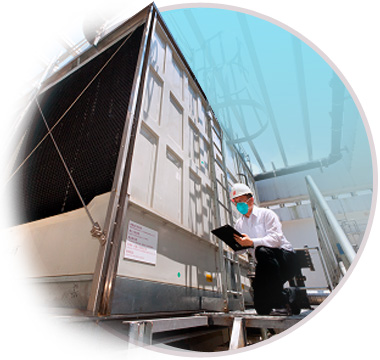Rationale for Using WACS
 The use of air conditioning in Hong Kong attributes a large proportion of our total electricity consumption due to its geographic location and economic activities. The use of air conditioning is expected to grow further in view of our increasing population and economic activities and therefore we need to take measures to improve our energy efficiency, in particular, on air conditioning. We should aim at reducing our energy demand and minimize the emission of greenhouse gases from our power generation plants to protect our environment through using energy-efficient water-cooled air conditioning systems.
The use of air conditioning in Hong Kong attributes a large proportion of our total electricity consumption due to its geographic location and economic activities. The use of air conditioning is expected to grow further in view of our increasing population and economic activities and therefore we need to take measures to improve our energy efficiency, in particular, on air conditioning. We should aim at reducing our energy demand and minimize the emission of greenhouse gases from our power generation plants to protect our environment through using energy-efficient water-cooled air conditioning systems.
Examples of adopting the energy-efficient WACS in Hong Kong are: WACS using fresh water cooling towers for individual building, WACS using seawater cooling for individual building and the large scale District Cooling System for numerous buildings.
WACS using Fresh Water Cooling Towers for Individual Building
WACS using fresh water cooling towers for individual building is generally more energy-efficient, consuming up to 20% less electricity than air-cooled air conditioning systems. Owners of non-domestic buildings1 and other buildings2 are encouraged to use fresh water cooling towers and to join the Fresh Water Cooling Towers Scheme.
WACS using Seawater Cooling for Individual Building
In Hong Kong, the most widely adopted seawater cooled air conditioning system for individual building is the once-through water cooling system. Once-through water cooling system is applied in large centralized air conditioning installation in locations where sufficient cooling water is available, such as those along the seafront of Victoria Harbour. The once-through water cooling system uses seawater to take away heat of condenser and eventually discharge to the sea.
District Cooling System (DCS)
What is DCS and how it operates?
DCS is a centralized cooling system which provides chilled water to the air-conditioning system of numerous user buildings for cooling purpose. The central chiller plant supplies chilled water and conveys it to the user buildings via underground chilled water pipe network. DCS is an energy-efficient air-conditioning system as it consumes 35% and 20% less electricity as compared with traditional air-cooled air-conditioning systems and individual WACS using fresh water cooling towers respectively. DCS commonly uses either seawater or cooling towers as the method of heat disposal during the production of the chilled water.
Benefits to Society
- Highly energy-efficient feature of DCS enables energy saving up to 35% compared with conventional air-cooled air-conditioning systems.
- Environmentally friendly system as it consumes less electrical energy and hence produces less greenhouse gases and contaminants to the environment. Other environmental problems caused by the chillers, such as noise, vibration, and thermal plume are also resolved as no chiller plant is required in the end-user building.
- Architectural benefits such as more freedom in architectural and facilities design, can be achieved from elimination of roof top chiller plant, resulting in roof space available for installation of sky garden or PV panels.
Benefits to End-users
- Reliability and Quality are superior to conventional air-conditioning. With a team of professional engineers and supporting staff, DCS's computerized Central Chiller Plant ensures stable cooling supply to the end-user building at all time.
- Save plant room space with an average of 70% for end-user building.
- Flexible design to meet growth of cooling demand and extended service hours easily.
- Save initial cost as no need to build its own chiller plant.
- Save maintenance and operation cost due to less serviceable equipment and higher efficiency.
STUDIES
EMSD completed three consultancy studies on Water-cooled Air Conditioning Systems in Hong Kong from 2002 to 2005, namely "Territory-wide Implementation Study of water-cooled Air Conditioning Systems in Hong Kong", "Implementation Study for a District Cooling Scheme at South East Kowloon Development" and "Implementation Study for Water-cooled Air Conditioning Systems at Wan Chai and Causeway Bay - Investigation". Please click here for the executive summaries of the study and other related reports.
Water-cooled Air Conditioning Systems (WACS)
 The use of air conditioning in Hong Kong attributes a large proportion of our total electricity consumption due to its geographic location and economic activities. The use of air conditioning is expected to grow further in view of our increasing population and economic activities and therefore we need to take measures to improve our energy efficiency, in particular, on air conditioning. We should aim at reducing our energy demand and minimize the emission of greenhouse gases from our power generation plants to protect our environment through using energy-efficient water-cooled air conditioning systems.
The use of air conditioning in Hong Kong attributes a large proportion of our total electricity consumption due to its geographic location and economic activities. The use of air conditioning is expected to grow further in view of our increasing population and economic activities and therefore we need to take measures to improve our energy efficiency, in particular, on air conditioning. We should aim at reducing our energy demand and minimize the emission of greenhouse gases from our power generation plants to protect our environment through using energy-efficient water-cooled air conditioning systems.